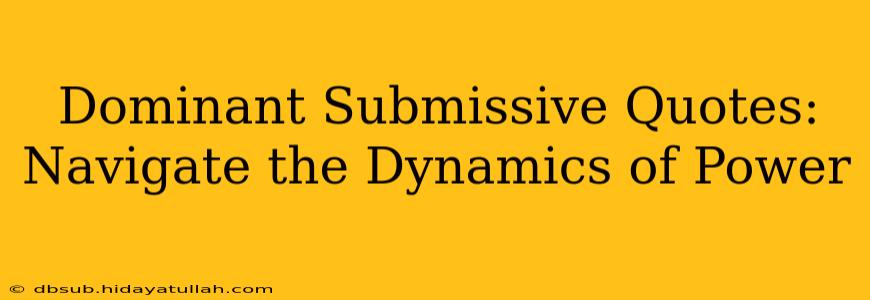Dominant/submissive (D/s) dynamics are a complex and multifaceted aspect of human relationships, often explored in various contexts, from literature and film to personal relationships. Understanding the nuances of power exchange within these dynamics requires careful consideration and a nuanced perspective. This exploration delves into the complexities of D/s relationships, examining common misconceptions and offering insights into the dynamics at play. We'll also explore some compelling dominant submissive quotes that illuminate the intricate nature of this power exchange.
What is a Dominant/Submissive Relationship?
Before diving into quotes, it's crucial to establish a clear understanding of D/s dynamics. It's not simply about one person being "in charge" and the other being "obedient." A healthy D/s relationship is built on mutual respect, consent, and clear communication. The power exchange is negotiated and agreed upon by both partners, with both individuals actively participating in shaping the dynamic. It's a collaborative exploration of power, not a hierarchical power struggle. The dominant partner doesn't control the submissive partner; rather, they guide and direct within the agreed-upon boundaries.
Common Misconceptions about D/s Relationships
Many misconceptions surround D/s relationships, often rooted in stereotypes and misunderstandings. Let's address some of these:
- Abuse and coercion: Healthy D/s relationships are built on consent. Any instance of coercion, violence, or non-consensual activity is abuse, not D/s. The power exchange is always consensual and negotiated.
- Lack of equality: While there's an unequal distribution of power, this doesn't equate to inequality. Both partners are equal in value and respect, even within the power dynamic. The power imbalance is a chosen aspect of the relationship, not a reflection of inherent worth.
- One-sided control: The dominant partner guides and directs, but the submissive partner is not a passive recipient. They actively participate in shaping the dynamic, expressing their boundaries and preferences. It’s a collaborative act.
Dominant Submissive Quotes: Exploring the Nuances of Power
Now, let's explore some quotes that illuminate the complexities of D/s dynamics. Remember, the interpretation of these quotes varies depending on individual perspectives and the specific context of the relationship:
"Power is not about control, but about influence." – This quote highlights the subtle difference between forceful control and the more nuanced influence exerted in a consensual D/s dynamic. The dominant partner's influence stems from mutual respect and agreed-upon boundaries, not dominance.
"Submission is not weakness, but empowerment." – This quote challenges the common misconception that submission equates to weakness. For some, submission can be an act of empowerment, allowing them to explore vulnerability and trust within a safe and consensual space.
"The joy is in the surrender." – This suggests the pleasure derived from relinquishing control and trusting another person within the context of a D/s relationship. This surrender requires vulnerability and trust from the submissive partner.
"Dominance is not about cruelty, but about responsibility." – This challenges the association of dominance with aggression or cruelty. In a healthy D/s relationship, the dominant partner holds responsibility for maintaining boundaries, ensuring safety, and providing guidance within the established parameters.
Exploring Different Aspects of D/s Dynamics: Addressing Common Questions
Here we address some frequently asked questions about dominant/submissive relationships:
What are the benefits of a D/s relationship?
The benefits vary greatly from couple to couple. Some find it enhances intimacy, communication, and personal growth. The clearly defined roles can create a sense of security and predictability, allowing for exploration of power dynamics in a safe space. It's important to emphasize that these benefits only exist when mutual respect, consent, and clear communication are fundamental pillars of the relationship.
How can I find a partner who is compatible with my D/s interests?
Open and honest communication is key. Expressing your interests respectfully and honestly is crucial. Finding compatible partners often involves seeking out communities and spaces where D/s lifestyles are discussed openly and respectfully. Remember to prioritize safety and consent above all else.
How do I set boundaries in a D/s relationship?
Setting clear and firm boundaries is essential in any relationship, but particularly in D/s dynamics. This involves open communication, a willingness to negotiate, and respect for each other's limits. It's a continuous process of conversation and adjustment to ensure both partners feel safe and comfortable.
What are some warning signs of an unhealthy D/s relationship?
Warning signs include coercion, lack of consent, abuse (physical or emotional), controlling behavior, and a disregard for boundaries. If any of these are present, the relationship needs immediate intervention. Seek support from professionals or support groups specializing in healthy relationship dynamics and D/s relationships.
In conclusion, dominant/submissive relationships are diverse and complex. Understanding the nuances of power, consent, and communication is crucial for navigating these dynamics safely and respectfully. Open dialogue, established boundaries, and mutual respect are the cornerstones of a healthy D/s relationship. Always prioritize safety and consent.
